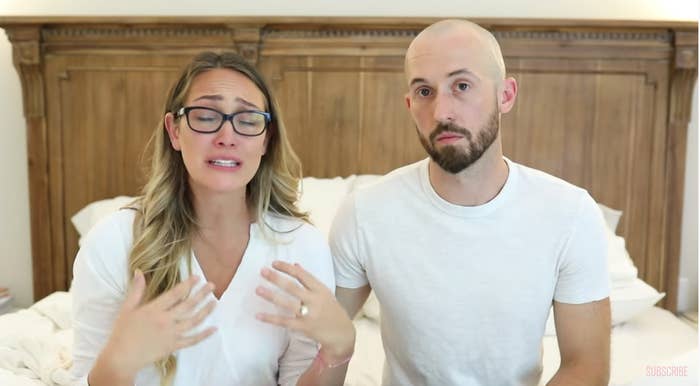
When family YouTubers Myka and James Stauffer announced this week that they had chosen to place their 4-year-old adopted autistic son, Huxley, with another family, it caused an international uproar.
Thousands of people all over the world had questions about how this could have happened, where Huxley is now, and what, if any, consequences the Stauffer family will face.
Two days later, a lot about Huxley's current whereabouts are still unknown. The Stauffers have gone dark on their social media accounts since announcing Huxley would no longer be a member of their family, and they have repeatedly declined to speak to BuzzFeed News. Through their lawyers, the couple said they would not be releasing any details about why they made the decision to dissolve the adoption or where Huxley is now, citing privacy concerns.
Based on the family's statements to the media so far and on their YouTube channels, it is unclear whether the Stauffer family found a new home for Huxley through an aboveboard, properly vetted process known as "adoption dissolution," or an underground, maligned practice known as "rehoming."
One place we do know Huxley is not is with the state government of Ohio, where the family lives. Val Turner, a spokesperson for the family's local child protection agency, Franklin County Children Services, confirmed to BuzzFeed News that Huxley is not in its custody.
"The adoption for the Stauffer family is an international adoption which does not involve our agency," Turner said, adding, "It appears that [Myka] made arrangements with an individual person, versus an agency."
Turner added that the agency is "obligated to investigate a report of abuse or neglect" if one should arise, but any involvement would be confidential.
In the US, there are two very different ways a child who has been adopted internationally can be placed with a new family. The first is known as "rehoming," or "unregulated custody transfers," Chuck Johnson, the president and CEO of the National Council for Adoption, told BuzzFeed News. And while it's incredibly frowned upon by adoption advocates, it's not illegal in many places in the US, including, it seems, Ohio.
"There are some states that prohibit it but even in some of these states, the statute is not always clear and the penalties vary – and many states have no prohibition," Johnson said. "We’d like to see creation of a national standard prohibiting it."

In these cases, Johnson said, an adoptive family can "bypass all the legal requirements, the courts, the child welfare system, and place them with another family without regard for their safety." Johnson said he and other advocates are currently working to outlaw this form of child swapping, the existence of which has been featured in several news reports, including an in-depth Reuters investigation in 2013.
"We do want to see the rehoming issue, that's the illegal part, we want to see it prohibited, we want that stopped and prohibited by law, and punishable if people engage in that illegal, very dangerous practice," he said.
The State Department also spoke out against the practice in its latest annual report on intercountry adoption, saying, "this practice poses serious safety concerns for adopted children as well as legal ramifications for adoptive parents."
However, there is an aboveboard way for parents to place an adoptive child with a new family, in a process known as an adoption dissolution. According to the National Council for Adoption, this occurs when "parents that have finalized an adoption relinquish their parental rights to that child; the child is then either adopted a second time by another family, or placed in the state foster care system."
These cases where the child is adopted by a new family can be facilitated by the adoption agency independent of the state or federal government, Johnson said, but the agencies are required to report such transfers to the government.
"Properly licensed child placement agencies have the same authority that a state agency would have in terms of legally able to take responsibility for a child and make placement decisions," Johnson said. He added that eventually the new family will need to go through the court system to adopt the child legally.
These adoption dissolutions, or "disruptions," which is when an adoption is canceled before the child is legally adopted, are rare, but they do happen every year. According to the State Department, in fiscal year 2019, eight adoptions were disrupted out of 2,971 total international adoptions. The children ranged from 2 to 13 years old. Some remained in their home country and were returned to orphanages, and others were placed with new families. In fiscal year 2018, the adoptions of four children, all ages 5 and under, were disrupted. The reasons ranged from medical and behavioral issues to the parents changing their minds or being unprepared.
The Stauffers did not return a request for more information on which adoption agency they used, but Myka stated on YouTube in the past that Huxley was adopted through the World Association for Parents and Children, or WACAP.
In 2019, WACAP merged with Holt International, one of the oldest and well-established international adoption agencies in the US. Susan Soonkeum Cox, the vice president for policy and external affairs for Holt International, told BuzzFeed News the agency could not comment on whether they were involved in the Stauffer adoption. However, she said in a general sense, the way the Stauffers went about this was unusual.
"Putting it on social media and describing it as, 'We found another family,' well what does that mean?" Cox said. "Did they go through an agency? Was there another home study done on the other family? That part is highly unusual."
Cox said unfortunately not every adoption works or is a good fit, and parents who believe they can no longer take care of their child need to work closely with their agency to access resources to help.
"There are times that there is a relinquishment and a reassignment does happen, and it's tragic for everybody, and in particular for the child," she said.
Cox, herself an international adoptee from South Korea who is a preeminent voice in international adoption and child welfare issues, echoed Johnson's sentiments against "rehoming" a child with no oversight, calling it "unethical and improper."
"Rehoming, the practice of just taking a child from one family to another, there's absolutely no process," she said. "There's nothing that makes that okay ... there's nothing in there that protects the child."
Holt International goes through a series of counseling and evaluations once they learn a family wants to find a new home for their adopted child, Cox said.
"If a family relinquishes their parental rights to the child they adopted, we would work to find a family for that child," she said.
It's unclear from the Stauffer family's statements, or that of their lawyers, who exactly was involved in finding and vetting the new family Huxley is now presumably in the care of, or who they consulted when making the decision. In the statement, the couple's lawyers cited "a team of medical professionals" who "advised our clients it might be best for Huxley to be placed with another family," but offered no further details. They also said the couple "consulted with multiple professionals in the healthcare and educational arenas in order to provide Huxley with the best possible treatment and care."
The lawyers stated that the Stauffers had "hand-select[ed] a family who is equipped to handle Huxley’s needs." In the video announcing the decision, Myka Stauffer said only that the family was the "perfect match for Huxley."
“He is thriving, he is very happy, he is doing really well, and his new mommy has medical professional training and it is a very good fit,” she said, later writing in a comment, “We saw that in family time with other people, he constantly choose [sic] them and signed and showed tons of emotion to show us and let us know he wanted this."
When BuzzFeed News asked the Stauffers to clarify who was involved in the transfer of Huxley, what vetting process was used, and if the adoption agency was involved in the transfer, they did not return a request for comment.
